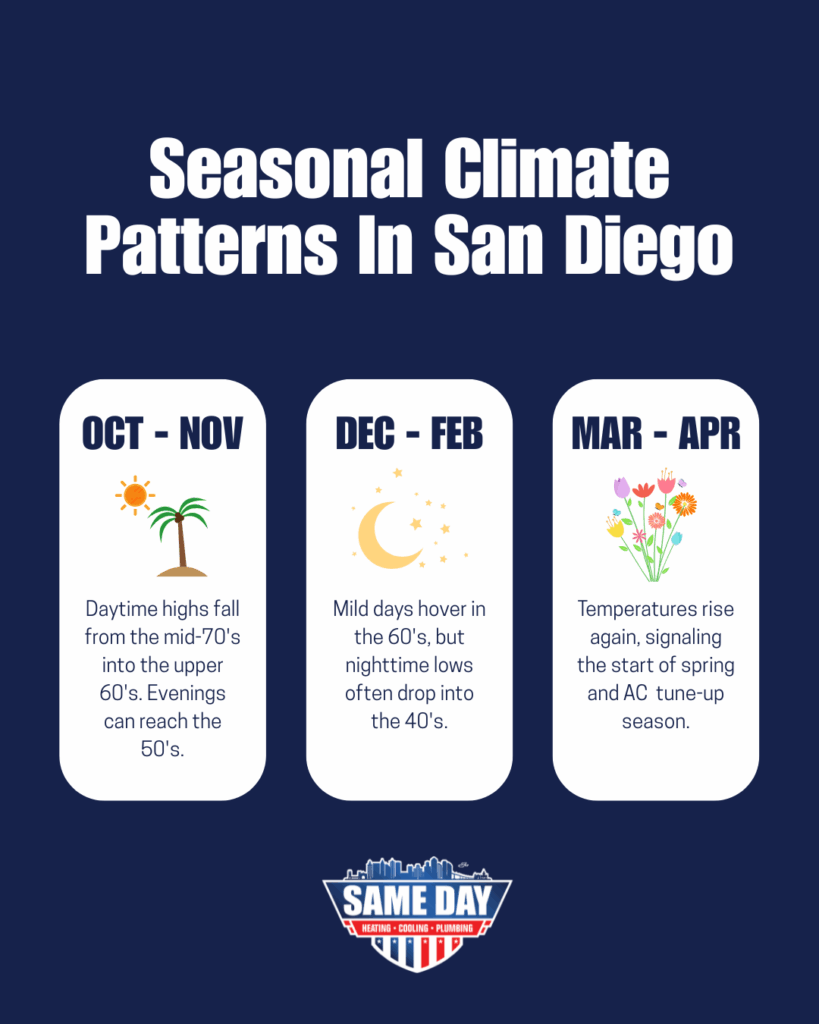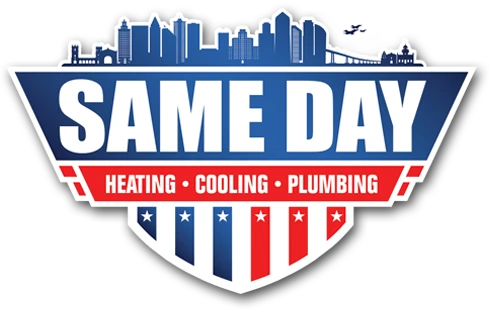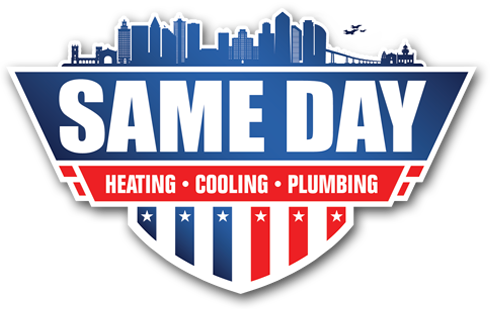When Should I Shut Down My San Diego AC for Winter?
Quick Summary: San Diego homeowners should shut down their AC once temperatures consistently drop below 60–65°F, usually in late October or early November. Doing so prevents coil damage, reduces energy waste, and extends system life. Clean the outdoor unit, turn off power, and schedule professional maintenance to prepare for next cooling season.
Even though San Diego is famous for its year-round sunshine, there is a time when your air conditioner deserves a break. As temperatures cool off toward the end of fall, running your AC too long can waste energy and even damage the unit. So, when exactly should you shut down your AC for winter — and what should you do to prepare it for the colder months?
When to Turn Off Your AC in San Diego
The best time to shut down your AC in San Diego is when outdoor temperatures consistently drop below 60–65°F, typically around late October or early November.
Because San Diego winters are mild, there’s no set calendar date — it’s about monitoring weather patterns. Once the days are cool and nights are chilly, it’s safe to switch the system off completely.
Why this range? Running your AC when it’s below 60°F can cause the unit’s evaporator coil to freeze, leading to unnecessary wear and possible compressor damage. Waiting until temperatures remain in the mid-60s or lower for several days in a row helps prevent this.
Seasonal Climate Patterns in San Diego
While San Diego’s climate rarely dips below freezing, there’s still a noticeable seasonal change:
- October–November: Daytime highs fall from the mid-70s into the upper 60s. Evenings can reach the 50s.
- December–February: Mild days hover in the 60s, but nighttime lows often drop into the 40s.
- March–April: Temperatures rise again, signaling the start of spring and AC tune-up season.
Because of these gradual shifts, San Diego residents don’t rely on their AC year-round — but ignoring seasonal maintenance can shorten the life of your system.

Signs It’s Time to Shut Down Your AC
Not sure if it’s time yet? Watch for these simple indicators:
- You’re rarely using it: If your home stays comfortable without cooling, shutting it off will save energy.
- Nighttime lows dip below 55°F: The cooler nights are a cue that your system is no longer needed for cooling.
- You notice condensation or ice on the unit: This can happen if it’s running in colder weather — a clear sign to power it down.
- Your energy bills are dropping naturally: When outdoor temps cool, the need for AC decreases, signaling it’s time for seasonal shutdown.
Why Shutting Down Your AC Matters
Many homeowners assume their AC can simply “sit idle,” but turning it off properly makes a big difference. Here’s why it matters:
1. Prevents Mechanical Damage
Running the unit in cool weather increases the risk of coil freezing, which can strain the compressor and shorten its lifespan. Turning it off before temperatures drop too low prevents this.
Your system cycles less often as the weather cools. Shutting it down completely ensures you’re not wasting energy on unnecessary operation.
3. Keeps the System Clean
San Diego’s dry autumn can blow dust and debris into outdoor units. Turning off power and covering the condenser prevents buildup and corrosion during the off-season.
4. Extends System Lifespan
Proper seasonal maintenance — including shutdown in winter — reduces wear, helping your AC last years longer before needing replacement.
How to Shut Down Your AC for Winter
A little end-of-season care goes a long way. Here’s a quick step-by-step guide:
- Turn off power at the disconnect box.
This prevents accidental operation during cold spells and protects against short circuits. - Clean the unit.
Remove leaves, dirt, and debris from the condenser area using a soft brush or vacuum. - Inspect for damage.
Check fan blades and refrigerant lines for visible wear or corrosion before covering the unit. - Cover (optional).
Use a breathable AC cover — never plastic — to protect against debris without trapping moisture. - Schedule fall maintenance.
Have a professional perform a 26-point inspection to ensure your system is ready for the next cooling season.
Should You Switch to Heating Instead?
As you turn off the AC, it’s time to focus on your heating system — whether that’s a furnace, heat pump, or ductless unit.
San Diego’s mild winters make heat pumps an increasingly popular option since they handle both heating and cooling efficiently. If you already have a dual-function system, you don’t need to shut it down — just switch modes and let it maintain your indoor comfort automatically.
Fall Air Quality and Comfort in San Diego
Even though AC usage drops, indoor comfort still matters during the cooler months. Fall in San Diego often brings Santa Ana winds, which can increase allergens and dust. Without the AC’s filtration running, it’s worth checking your indoor air quality (IAQ) systems:
- Replace or clean air filters before winter.
- Consider adding an air purifier or UV light to your system.
- Schedule duct cleaning if it’s been more than 3 years.
Cleaner air keeps your home comfortable even when your AC is resting.
When to Schedule Your Next AC Tune-Up
Once spring rolls around, plan your annual AC maintenance between March and May — before the first heatwaves of summer.
This timing allows technicians to spot wear, check refrigerant levels, and test the unit’s performance after winter downtime. Homeowners who maintain their systems regularly often see up to 40% longer lifespan and lower repair costs over time.
Seasonal Energy Tips for San Diego Homeowners
San Diego’s mild climate offers opportunities to save energy all year:
- Use ceiling fans to circulate warm air in winter and cool air in summer.
- Adjust your thermostat: Set it around 68°F in winter for efficiency.
- Seal leaks: Caulk windows and insulate doors to reduce heat loss.
- Inspect your ductwork: Properly sealed ducts improve HVAC performance by up to 20%.
These steps complement your seasonal AC shutdown and help you save money while keeping your home comfortable.
Why Professional Maintenance Still Matters
Even if your AC seems to be working fine, professional care ensures that minor issues don’t turn into major repairs.
Technicians can check refrigerant pressure, electrical connections, and airflow — all critical for efficiency and safety. Plus, a technician can confirm when it’s safe to fully power down your system based on your home’s specific setup.
Keep Your HVAC Running Smoothly Year-Round
Whether it’s turning off your AC for winter or prepping for next spring, proactive maintenance helps you avoid emergencies, reduce costs, and keep your system in top shape.
If you’re unsure when to shut down your system or want a professional inspection before winter, contact Same Day Heating & Air. Our technicians offer complete seasonal tune-ups, inspections, and maintenance plans designed for San Diego’s unique climate.

